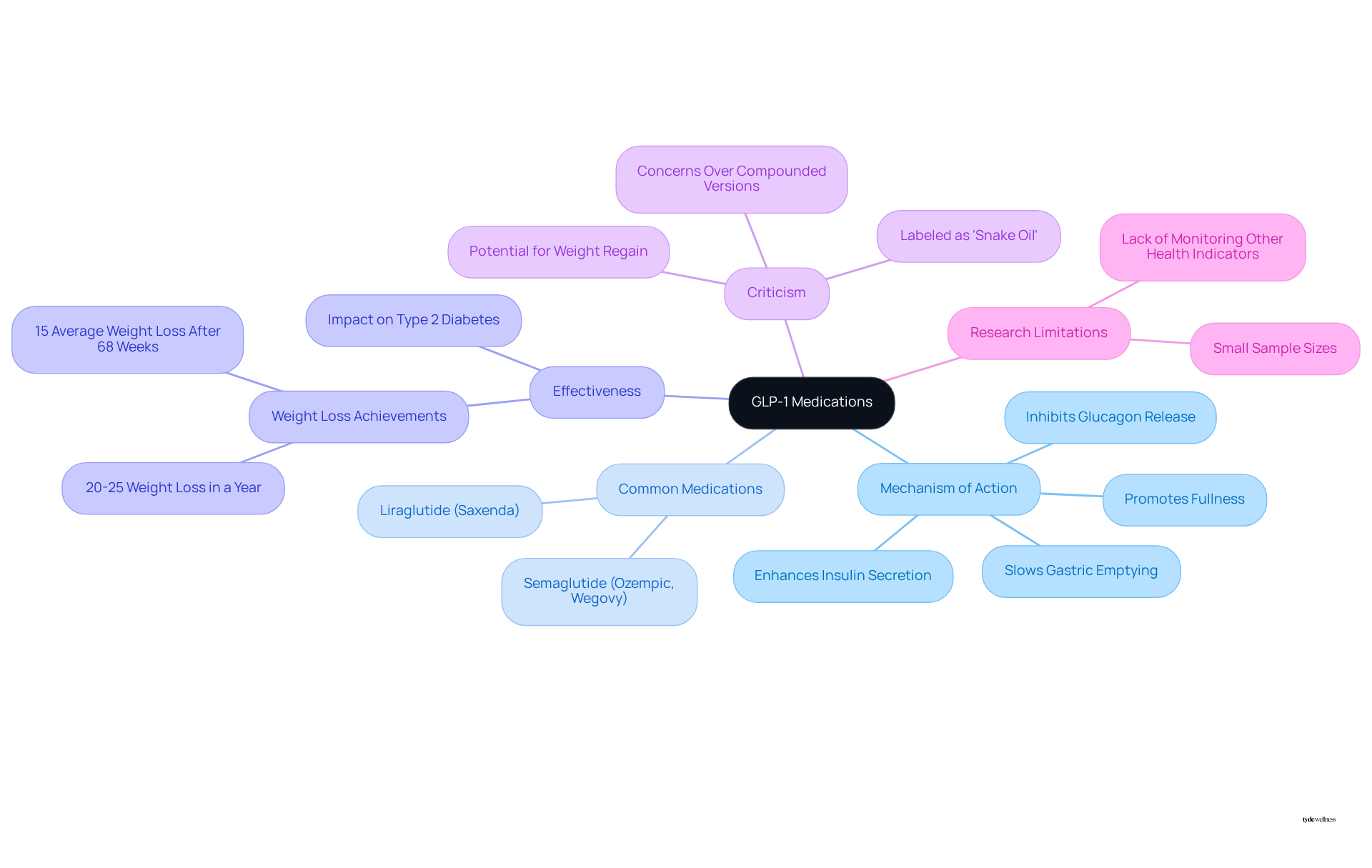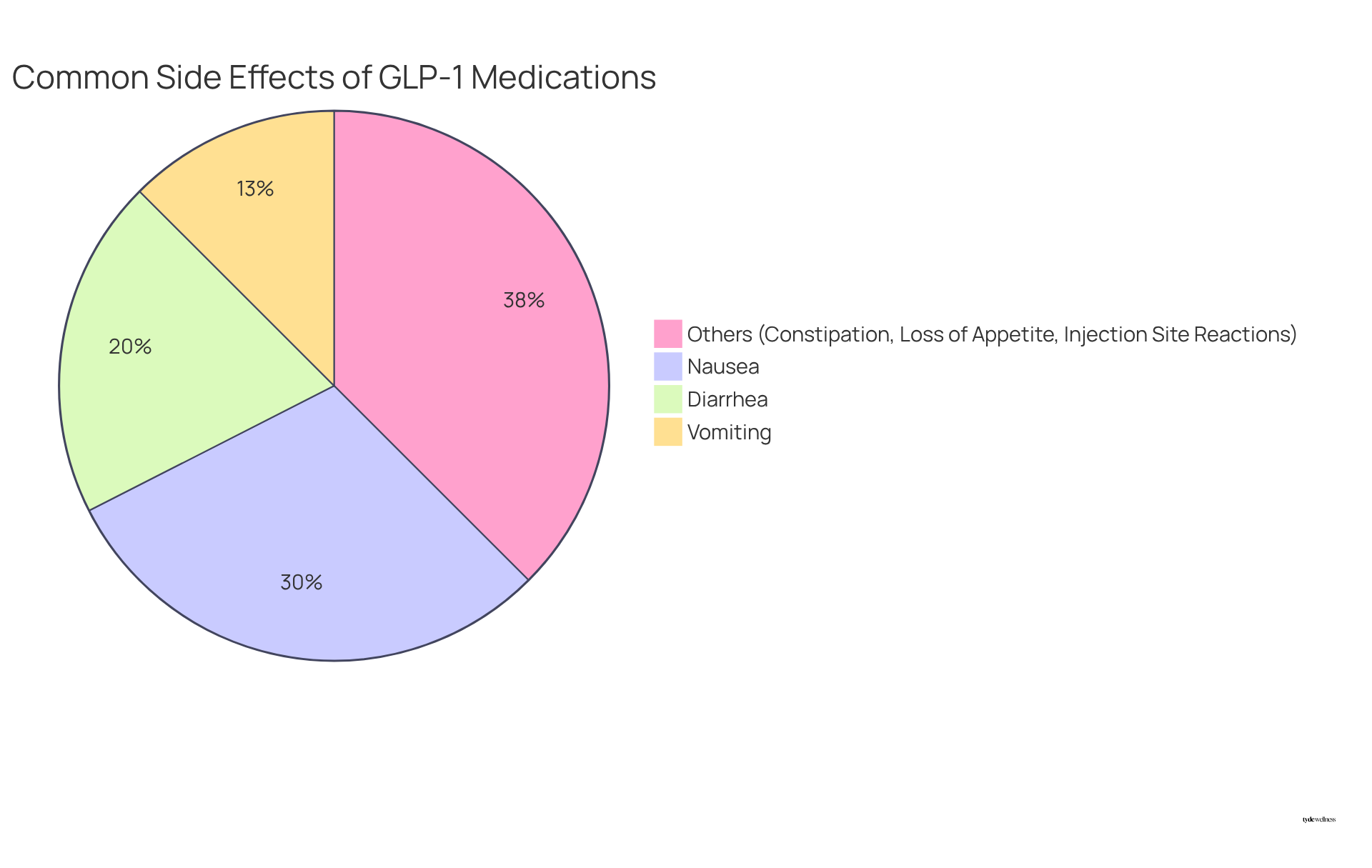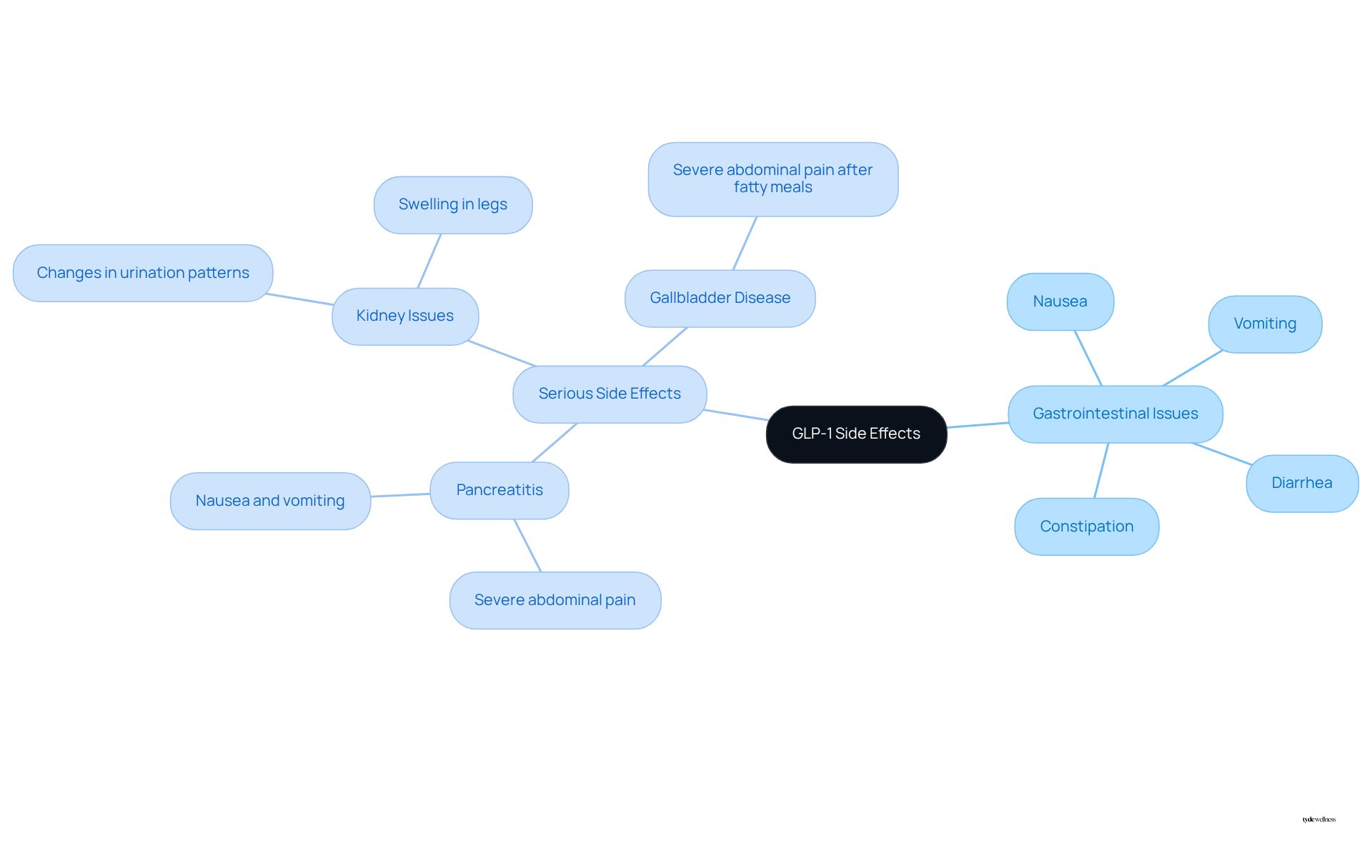Overview
The article addresses the side effects of GLP-1 medications, detailing common issues such as:
- nausea
- vomiting
- gastrointestinal discomfort
Additionally, it highlights serious risks, including:
- pancreatitis
- kidney problems
The prevalence of these side effects among users is supported by relevant data, emphasizing the importance of gradual dosage increases. Furthermore, it advocates for open communication with healthcare providers to effectively manage and mitigate adverse reactions.
Introduction
GLP-1 medications have emerged as a transformative solution for managing obesity and type 2 diabetes. These therapies mimic the body’s natural hormones, enhancing insulin secretion and promoting weight loss. However, as their popularity grows, it becomes increasingly important to raise awareness about the potential side effects associated with these treatments.
What strategies can individuals employ to navigate the complexities of GLP-1 side effects while maximizing the benefits of their treatment? Understanding the nuances of these medications is crucial for patients aiming to achieve their health goals without compromising their well-being.
Overview of GLP-1 Medications and Their Mechanism of Action
GLP-1 (glucagon-like peptide-1) therapies represent a class of substances designed to mimic the action of the naturally occurring hormone GLP-1 in the body. These drugs enhance insulin secretion in response to meals, inhibit glucagon release—which typically raises blood sugar levels—and slow gastric emptying. This multifaceted approach not only aids in regulating blood sugar levels but also promotes a feeling of fullness, facilitating weight loss. Common medications in this class include semaglutide (Ozempic, Wegovy) and liraglutide (Saxenda). Their effectiveness in addressing obesity and type 2 diabetes has led to widespread use in weight loss programs, particularly among women experiencing hormonal changes during perimenopause and menopause.
Studies indicate that individuals participating in programs utilizing these therapies frequently experience significant weight loss, with many achieving reductions exceeding 20-25% within a year. However, it is important to acknowledge criticisms surrounding certain supplements, as some experts have labeled them as ‘snake oil’ and caution against spending money on unproven alternatives. Furthermore, the FDA has halted the progress of compounded versions of these medications for weight loss, impacting the current landscape of available treatments.
While Tyde Wellness reports an average body weight reduction of 15% after 68 weeks, the potential for weight regain within two months after discontinuing these treatments underscores the need for ongoing management strategies. Moreover, recent research presents limitations, such as small sample sizes and a lack of monitoring for other health indicators, which must be considered when evaluating the long-term effects of this therapy.

Common Side Effects of GLP-1 Medications
GLP-1 medications are generally well-accepted; however, individuals should be aware of various potential side effects. The most common include:
- Nausea, which is frequently reported at the beginning of treatment but often diminishes over time as the body adjusts. Research indicates that approximately 30% of individuals experience this side effect initially.
- Vomiting may also occur, but it typically lessens as treatment progresses. Reports suggest that around 10-15% of individuals may experience vomiting during the early stages.
- Diarrhea can be a concern, particularly in the initial phases of therapy, affecting about 20% of users.
- Constipation, highlighting the variability in gastrointestinal responses.
- Loss of appetite, while often a desired effect, can lead to unintended weight loss if not monitored closely, with some individuals reporting significant changes in their eating habits.
- Injection site reactions, such as redness or irritation, are common but usually mild and resolve quickly.
It is crucial for individuals to understand these side effects and the potential dangers associated with compounded drugs. The FDA has received 520 reports of adverse events related to compounded semaglutide, including serious complications like bowel obstruction and pancreatitis. This underscores the importance of obtaining prescriptions from state-licensed pharmacies to ensure safety.
Patients are encouraged to discuss any adverse experiences with their healthcare providers, as this dialogue can lead to improved management strategies and necessary adjustments in therapy. Moreover, the FDA urges healthcare providers and individuals to report any adverse events or quality issues with medications, emphasizing the theme of accountability in care.

Gastrointestinal and Serious Side Effects: What to Watch For
In addition to the common GLP-1 side effects, patients should be vigilant about gastrointestinal issues and serious complications that may arise from GLP-1 therapy.
Gastrointestinal issues can include persistent nausea, vomiting, diarrhea, or constipation, which may lead to dehydration and electrolyte imbalances. It is essential for individuals to monitor their hydration levels and dietary intake closely. Reports indicate that gastrointestinal side effects, including significant discomfort for some individuals, are among the most frequently experienced by users. Research shows that 50 to 85 percent of individuals cease utilizing GLP-1s within two years, highlighting the challenges and potential dissatisfaction with the treatment.
Serious side effects, although rare, can occur and include:
- Pancreatitis: Symptoms such as severe abdominal pain, nausea, and vomiting warrant immediate medical attention. For instance, Lorna Edgar’s experience with Saxenda underscores this risk; she developed acute pancreatitis after using the treatment, resulting in long-term health issues. Research has indicated a concerning link between certain drugs and pancreatitis, with some individuals facing severe episodes after beginning therapy.
- Kidney Issues: Changes in urination patterns or swelling in the legs may indicate kidney problems, necessitating prompt evaluation.
- Gallbladder Disease: Symptoms may include severe abdominal pain, particularly after consuming fatty meals, which could signal gallbladder complications.
Patients are encouraged to maintain open communication with their healthcare providers to address any concerning symptoms promptly. Monitoring for GLP-1 side effects is crucial, as healthcare professionals emphasize the importance of initiating GLP-1 treatments at the lowest dose and gradually increasing it to minimize risks. Dr. Susan Spratt advises that individuals should be informed about the potential risks associated with these treatments. By staying informed and proactive, individuals can better navigate their weight loss journey while prioritizing their health.

Strategies for Managing GLP-1 Side Effects Effectively
Effectively managing the glp-1 side effects of these medications can significantly improve the treatment experience. Here are some practical strategies:
-
Start Low, Go Slow: Gradually increasing the dosage allows the body to adjust, which minimizes side effects such as nausea. As Dr. Jeff Livingston highlights, “Every individual’s experience with GLP-1 treatments is distinct, and there’s no universal solution.”
-
Stay Hydrated: Adequate fluid intake is crucial; it alleviates nausea and helps prevent dehydration, which can worsen symptoms like headaches and dizziness. Staying hydrated is essential for preventing constipation, especially when appetite is low.
-
Dietary Adjustments: Consuming smaller, more frequent meals can mitigate gastrointestinal discomfort. It’s advisable to avoid heavy, fatty foods and artificial sweeteners, as they can exacerbate feelings of nausea. Incorporating ginger or peppermint may also provide relief from nausea.
-
Monitor Fiber Intake: A balanced fiber intake is essential for managing constipation. Aim for 25-35 grams daily, but increase fiber gradually to avoid exacerbating gastrointestinal issues. Tonya F. Turner observes, “It’s often challenging to obtain sufficient fiber since individuals are consuming very little, so supplementation can be essential.”
-
Consult Healthcare Providers: Regular communication with healthcare providers is vital for tailoring the treatment plan and addressing any emerging concerns. If nausea becomes severe, individuals should seek medication assistance or consider modifying their dosage.
By implementing these strategies, patients can enhance their comfort and the overall effectiveness of GLP-1 therapy while considering GLP-1 side effects, ultimately improving their weight loss journey.

Conclusion
Understanding the side effects of GLP-1 medications is crucial for individuals considering or currently using these therapies. These medications, designed to mimic the natural hormone GLP-1, offer significant benefits for managing blood sugar levels and promoting weight loss. However, awareness of potential side effects—ranging from common gastrointestinal issues to more serious complications—is essential for ensuring safe and effective treatment.
Throughout the article, key insights were provided regarding both the common and serious side effects associated with GLP-1 therapies, as well as practical strategies for managing these effects. Starting with low doses, maintaining hydration, and making dietary adjustments are all effective methods to alleviate discomfort. Furthermore, the importance of ongoing communication with healthcare providers cannot be overstated, as it allows for timely adjustments and support in navigating the treatment journey.
Ultimately, understanding and managing GLP-1 side effects is vital for maximizing the benefits of these medications. By implementing the outlined strategies and staying informed, individuals can enhance their treatment experience and work towards achieving their health goals. Taking proactive steps in monitoring and managing side effects not only empowers patients but also reinforces the commitment to safe and effective weight loss and diabetes management.
Frequently Asked Questions
What are GLP-1 medications and how do they work?
GLP-1 medications are designed to mimic the action of the naturally occurring hormone GLP-1 in the body. They enhance insulin secretion in response to meals, inhibit glucagon release, and slow gastric emptying, which helps regulate blood sugar levels and promotes a feeling of fullness.
What are some common GLP-1 medications?
Common medications in the GLP-1 class include semaglutide (Ozempic, Wegovy) and liraglutide (Saxenda).
How effective are GLP-1 medications for weight loss?
Studies show that individuals using GLP-1 therapies often experience significant weight loss, with many achieving reductions exceeding 20-25% within a year.
Who benefits most from GLP-1 medications?
GLP-1 medications are particularly beneficial for individuals with obesity and type 2 diabetes, especially women experiencing hormonal changes during perimenopause and menopause.
What concerns exist regarding the use of GLP-1 medications?
Some experts criticize certain supplements associated with weight loss, labeling them as ‘snake oil’ and cautioning against spending money on unproven alternatives. Additionally, the FDA has halted compounded versions of these medications for weight loss.
What results have been reported by Tyde Wellness regarding weight reduction?
Tyde Wellness reports an average body weight reduction of 15% after 68 weeks of using GLP-1 medications.
Is there a risk of weight regain after stopping GLP-1 medications?
Yes, there is potential for weight regain within two months after discontinuing these treatments, highlighting the need for ongoing management strategies.
What limitations exist in the research on GLP-1 therapies?
Recent research has limitations such as small sample sizes and a lack of monitoring for other health indicators, which should be considered when evaluating the long-term effects of this therapy.
List of Sources
- Overview of GLP-1 Medications and Their Mechanism of Action
- Study identifies benefits, risks linked to popular weight-loss drugs | WashU Medicine (https://medicine.washu.edu/news/study-identifies-benefits-risks-linked-to-popular-weight-loss-drugs)
- GLP-1s work but when they’re stopped, the effects stop too: Expert (https://abcnews.go.com/Health/glp-1s-work-stopped-effects-stop-expert/story?id=124009776)
- What to know about GLP-1 supplements for weight loss (https://nbcnews.com/health/health-news/glp-1-supplements-weight-loss-science-what-know-rcna201921)
- Optic Neuropathy and Other Hidden Ocular Risks of GLP-1 RA Weight Loss Drugs (https://neurologyadvisor.com/features/naion-hidden-ocular-risks-of-glp-1-ra-semaglutide-weight-loss-drugs)
- GLP-1 Drugs Fail to Provide Key Weight-Loss Benefit (https://newsroom.uvahealth.com/2025/07/21/glp-1-drugs-fail-to-provide-key-weight-loss-benefit)
- Common Side Effects of GLP-1 Medications
- GLP-1 diabetes and weight-loss drug side effects: (https://health.harvard.edu/staying-healthy/glp-1-diabetes-and-weight-loss-drug-side-effects-ozempic-face-and-more)
- FDA’s Concerns with Unapproved GLP-1 Drugs Used for Weight Loss (https://fda.gov/drugs/postmarket-drug-safety-information-patients-and-providers/fdas-concerns-unapproved-glp-1-drugs-used-weight-loss)
- Potentially fatal side effect of weight-loss drugs sparks new investigation (https://nypost.com/2025/07/06/health/potentially-fatal-side-effect-of-weight-loss-drugs-sparks-new-investigation)
- Serious side-effects for popular weight loss drugs raising concerns (https://komonews.com/news/spotlight-on-america/serious-side-effects-for-popular-weight-loss-drugs-raising-concerns-risk-benefits-health-obesity-glp1-zepbound-wegovy-mounjaro-semiglutide-medication)
- Gastrointestinal and Serious Side Effects: What to Watch For
- Popular weight loss drugs linked to rare but severe stomach problems, study finds (https://nbcnews.com/health/health-news/ozempic-wegovy-linked-severe-medical-conditions-stomach-problems-study-rcna118823)
- Weight loss and diabetes jabs linked to potentially fatal side effect (https://news.sky.com/story/weight-loss-and-diabetes-jabs-linked-to-potentially-fatal-side-effect-13388528)
- Serious side-effects for popular weight loss drugs raising concerns (https://kutv.com/news/spotlight-on-america/serious-side-effects-for-popular-weight-loss-drugs-raising-concerns-risk-benefits-health-obesity-glp1-zepbound-wegovy-mounjaro-semiglutide-medication)
- Study identifies benefits, risks linked to popular weight-loss drugs | WashU Medicine (https://medicine.washu.edu/news/study-identifies-benefits-risks-linked-to-popular-weight-loss-drugs)
- Strategies for Managing GLP-1 Side Effects Effectively
- How to Tame GLP-1 Side Effects: 6 Tips (https://blog.uvahealth.com/2025/04/02/glp-1-side-effects)
- Navigating Nausea While on GLP-1 Medications: Tips for a Smoother Journey – MacArthur Medical Center (https://macarthurmc.com/navigating-nausea-while-on-glp-1-medications-tips-for-a-smoother-journey)
- Managing GLP-1 Side Effects: Our Top Tips for Success: Hopkins MD: Primary Care Practice (https://hopkinsmd.com/blog/managing-glp-1-side-effects-our-top-tips-for-success)
- Expert Tips for Managing GLP-1 Medication Side Effects (https://medscape.com/viewarticle/expert-tips-managing-glp-1-medication-side-effects-2024a1000p8l)
- GLP-1 medications and weight loss: Helping patients navigate beyond the trends (https://wolterskluwer.com/en/expert-insights/glp-1-medications-and-weight-loss-help-patients-navigate-beyond-trends)